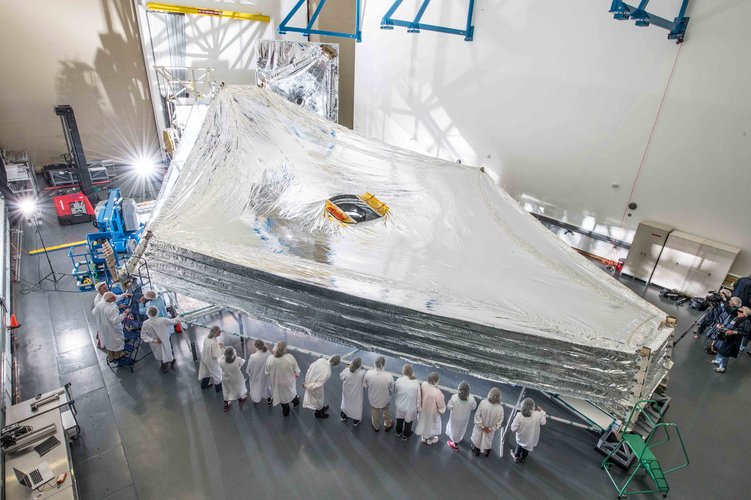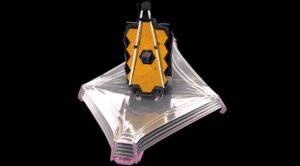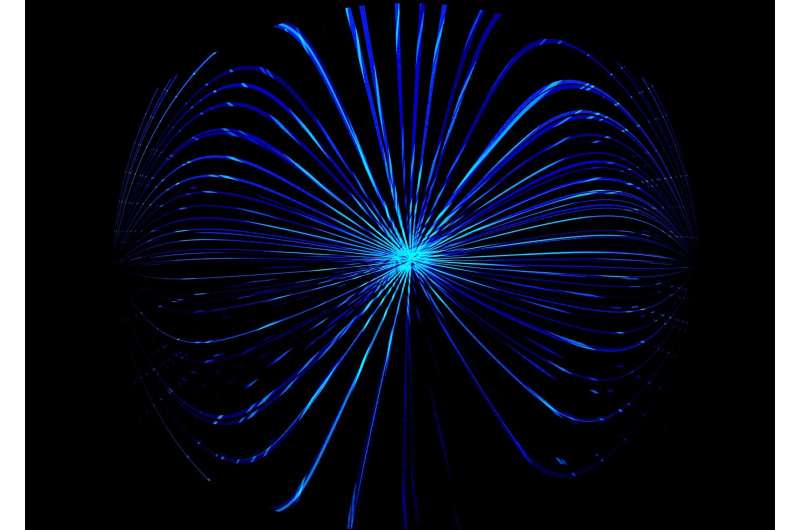Space business: The final (profitable) frontier
Wednesday, 05 January 2022 08:31 The snub-nosed craft resembles a shuttle-airplane mashup, and is the latest entrant in a profit-seeking push with staggering potential - and risks - for humans to visit, work or even live in space.
The display of technology like the life-size model "Dream Chaser" ship at the CES tech show in Las Vegas is a sharp signal that the commercial space era is upon us.
Experts see a path for
The snub-nosed craft resembles a shuttle-airplane mashup, and is the latest entrant in a profit-seeking push with staggering potential - and risks - for humans to visit, work or even live in space.
The display of technology like the life-size model "Dream Chaser" ship at the CES tech show in Las Vegas is a sharp signal that the commercial space era is upon us.
Experts see a path for Sunshield deploys on NASA's Next Flagship Telescope
Wednesday, 05 January 2022 08:31 The James Webb Space Telescope team has fully deployed the spacecraft's 70-foot sunshield, a key milestone in preparing it for science operations. The sunshield - about the size of a tennis court at full size - was folded to fit inside the payload area of an Arianespace Ariane 5 rocket's nose cone prior to launch. The Webb team began remotely deploying the sunshield Dec. 28, 2021, three days aft
The James Webb Space Telescope team has fully deployed the spacecraft's 70-foot sunshield, a key milestone in preparing it for science operations. The sunshield - about the size of a tennis court at full size - was folded to fit inside the payload area of an Arianespace Ariane 5 rocket's nose cone prior to launch. The Webb team began remotely deploying the sunshield Dec. 28, 2021, three days aft Resolving the black hole 'fuzzball or wormhole' debate
Wednesday, 05 January 2022 08:31 Black holes really are giant fuzzballs, a new study says. The study attempts to put to rest the debate over Stephen Hawking's famous information paradox, the problem created by Hawking's conclusion that any data that enters a black hole can never leave. This conclusion accorded with the laws of thermodynamics, but opposed the fundamental laws of quantum mechanics.
"What we found from strin
Black holes really are giant fuzzballs, a new study says. The study attempts to put to rest the debate over Stephen Hawking's famous information paradox, the problem created by Hawking's conclusion that any data that enters a black hole can never leave. This conclusion accorded with the laws of thermodynamics, but opposed the fundamental laws of quantum mechanics.
"What we found from strin China plans missions to moon's south pole
Wednesday, 05 January 2022 08:31 China has approved the fourth phase of its lunar exploration program, including a basic model of a research station built on the moon over the coming decade, according to the China National Space Administration.
Wu Yanhua, deputy director of the administration, said China would carry out lunar exploration in the future Chang'e-6, Chang'e-7 and Chang'e-8 missions.
As planned, Chang'e-
China has approved the fourth phase of its lunar exploration program, including a basic model of a research station built on the moon over the coming decade, according to the China National Space Administration.
Wu Yanhua, deputy director of the administration, said China would carry out lunar exploration in the future Chang'e-6, Chang'e-7 and Chang'e-8 missions.
As planned, Chang'e- Flight 19 - New Year, Same Ingenuity
Wednesday, 05 January 2022 08:31 The next flight on Mars marks the first of 2022 and the nineteenth for NASA's Ingenuity Mars Helicopter. The current mission goal is to reach the Jezero river delta to aid the Perseverance rover in path planning and scientific discovery.
This flight, which will take place no earlier than Friday, Jan. 7, takes the scout vehicle out of the South Seitah basin, across the dividing ridge, and u
The next flight on Mars marks the first of 2022 and the nineteenth for NASA's Ingenuity Mars Helicopter. The current mission goal is to reach the Jezero river delta to aid the Perseverance rover in path planning and scientific discovery.
This flight, which will take place no earlier than Friday, Jan. 7, takes the scout vehicle out of the South Seitah basin, across the dividing ridge, and u Sols 3347-3348: Bem Vindo a Roraima!
Wednesday, 05 January 2022 08:31 Tosol, Curiosity woke up in a new mapping quadrant, Roraima. The Roraima quadrant is named after the northern-most state of Brazil and Mount Roraima, which is the highest peak in the Pakaraima mountains which sits between Brazil, Venezuela, and Guyana.
The terrain in the Roraima region on Earth looks somewhat similar to the area Curiosity is in - with flat-topped hills and some steep slope
Tosol, Curiosity woke up in a new mapping quadrant, Roraima. The Roraima quadrant is named after the northern-most state of Brazil and Mount Roraima, which is the highest peak in the Pakaraima mountains which sits between Brazil, Venezuela, and Guyana.
The terrain in the Roraima region on Earth looks somewhat similar to the area Curiosity is in - with flat-topped hills and some steep slope China's Mars orbiter captures series of selfies using remote camera
Wednesday, 05 January 2022 08:31 The China National Space Administration released photos on New Year's Day, of its Mars orbiter circling high above the Red Plant.
The selfies were taken by a small camera which was deployed by the Tianwen 1, capturing images of the orbiter and sending them back to it via a WiFi connection.
The photos were then relayed back to Earth where they were published by China's space agenc
The China National Space Administration released photos on New Year's Day, of its Mars orbiter circling high above the Red Plant.
The selfies were taken by a small camera which was deployed by the Tianwen 1, capturing images of the orbiter and sending them back to it via a WiFi connection.
The photos were then relayed back to Earth where they were published by China's space agenc How scientists designed the orbit of the Chang'E 5 mission
Wednesday, 05 January 2022 08:31 In the early morning of November 24, 2020, the Chang'E 5 lunar probe was launched from the Wenchang Space Launch Center and successfully executed a 23-day journey of lunar sample return (LSR) mission. In a review paper recently published in Space: Science and Technology, Dr. Zhong-Sheng Wang and his colleagues from the Beijing Institute of Spacecraft System Engineering, addresses three key orbit
In the early morning of November 24, 2020, the Chang'E 5 lunar probe was launched from the Wenchang Space Launch Center and successfully executed a 23-day journey of lunar sample return (LSR) mission. In a review paper recently published in Space: Science and Technology, Dr. Zhong-Sheng Wang and his colleagues from the Beijing Institute of Spacecraft System Engineering, addresses three key orbit Quadrantid meteor shower offers good show outside of North America
Wednesday, 05 January 2022 08:31 The Quandrantid meteor shower helped kick off the first workday of the new year on Monday, with the peak somewhat tough to see in North America - but the rest of the world got a good show.
The "Quads" as they are nicknamed, are slated to peak around 4 p.m. EDT (2100 GMT) on Monday, according to Margaret Campbell-Brown and Peter Brown in the 2022 version of the Observer's Handbook of th
The Quandrantid meteor shower helped kick off the first workday of the new year on Monday, with the peak somewhat tough to see in North America - but the rest of the world got a good show.
The "Quads" as they are nicknamed, are slated to peak around 4 p.m. EDT (2100 GMT) on Monday, according to Margaret Campbell-Brown and Peter Brown in the 2022 version of the Observer's Handbook of th Asteroid 'Apophis' predicted to skim dangerously close to Earth in 2029
Wednesday, 05 January 2022 08:31 Earlier, NASA said that Apophis - the poster child for "hazardous asteroids" - was no longer deemed a threat for Earth based on a refined estimate of its orbit around the Sun.
Asteroid 99942 Apophis, estimated to measure 340 metres (1,100 ft) across and identified by the National Aeronautics and Space Administration (NASA) as one of the most hazardous asteroids that could impact Earth, wil
Earlier, NASA said that Apophis - the poster child for "hazardous asteroids" - was no longer deemed a threat for Earth based on a refined estimate of its orbit around the Sun.
Asteroid 99942 Apophis, estimated to measure 340 metres (1,100 ft) across and identified by the National Aeronautics and Space Administration (NASA) as one of the most hazardous asteroids that could impact Earth, wil The mysterious dusty object orbiting TIC 400799224
Wednesday, 05 January 2022 08:31 The Transiting Exoplanet Survey Satellite, TESS, was launched in 2018 with the goal of discovering small planets around the Sun's nearest neighbor stars. TESS has so far discovered 172 confirmed exoplanets and compiled a list of 4703 candidate exoplanets. Its sensitive camera takes images that span a huge field of view, more than twice the area of the constellation of Orion, and TESS has also as
The Transiting Exoplanet Survey Satellite, TESS, was launched in 2018 with the goal of discovering small planets around the Sun's nearest neighbor stars. TESS has so far discovered 172 confirmed exoplanets and compiled a list of 4703 candidate exoplanets. Its sensitive camera takes images that span a huge field of view, more than twice the area of the constellation of Orion, and TESS has also as Kerstin Perez is searching the cosmos for signs of dark matter
Wednesday, 05 January 2022 08:31 Kerstin Perez is searching for imprints of dark matter. The invisible substance embodies 84 percent of the matter in the universe and is thought to be a powerful cosmic glue, keeping whole galaxies from spinning apart. And yet, the particles themselves leave barely a trace on ordinary matter, thwarting all efforts at detection thus far.
Perez, a particle physicist at MIT, is hoping that a
Kerstin Perez is searching for imprints of dark matter. The invisible substance embodies 84 percent of the matter in the universe and is thought to be a powerful cosmic glue, keeping whole galaxies from spinning apart. And yet, the particles themselves leave barely a trace on ordinary matter, thwarting all efforts at detection thus far.
Perez, a particle physicist at MIT, is hoping that a Webb sunshield fully deployed
Wednesday, 05 January 2022 06:45
The NASA/ESA/CSA James Webb Space Telescope team has fully deployed the spacecraft’s sunshield in space, a key milestone in preparing it for science operations.
JWST sunshield fully deployed
Tuesday, 04 January 2022 23:56
Controllers completed the deployment of the sunshield of NASA’s James Webb Space Telescope Jan. 4, allowing the mission to move ahead to setting up the telescope itself.
Real-time alert system heralds new era in fast radio burst research
Tuesday, 04 January 2022 19:06
McGill University scientists have developed a new system for sharing the enormous amount of data being generated by the CHIME radio telescope in its search for fast radio bursts (FRBs), the puzzling extragalactic phenomenon that is one of the hottest topics in modern-day astronomy.
It is not uncommon for the CHIME/FRB project to pinpoint several FRB events in a single day of operation as it sifts through nearly 1 million gigabytes of data gathered by the telescope. With the new data sharing system, which uses Virtual Observatory Event (VOEvent), a standardized language for reporting astronomical events, key details about each FRB that CHIME detects can now be sent in real time to observatories all over the world, allowing them to train their instruments on the source and gather further clues towards unraveling the mystery of FRBs.
"The enormous volume of data that CHIME/FRB generates and the large number of new FRBs that it detects each day is like a gold mine for a community that is eager to point every kind of telescope that exists at the next FRB," says Andrew Zwaniga, lead developer of the CHIME/FRB VOEvent Service and a research assistant in the Department of Physics at McGill.

